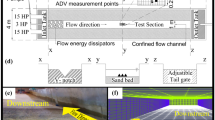Abstract
Among the various solutions proposed for these structures are stepped dams, which despite effectively reducing the flow pattern, weaken the vortex and dramatically lower the risk of vortex formation by reducing the size of the deadly roller. At high tailwater depths, however, the dimensions and submerged roller current strength can still be dangerous. Using triangular wedges as a complementing structure topping the step to change the vortex flow pattern is one method that has been addressed in previous studies. The present study investigates the effectiveness of these wedges on the proposed stepped design in reducing drowning risk at the Salmon Dam, the most dangerous dam in a pest management system that controls the immigrant sea lamprey population in the Great Lake of Ontario, Canada. It is shown that installing wedges on the steps, despite falling short of eliminating vertical vortex flow entirely, by changing the pattern and flow direction from vertical vortex to horizontal vortex, poses a risk of drowning in a wide range of tailwater depth. This study found that optimal wedge placement reduces the dangerous vertical roller area from 27 to 83% of the tailwater depth area. Moreover, using wedges on continuous steps retains the positive effect of wedges but also expands the range. The distance between the wedges wields significant influence on the flow pattern, but reducing the distance between them does not necessarily reduce the viewing range of this vertical roller.



















Similar content being viewed by others
Abbreviations
- Q :
-
Flow rate
- H 1 :
-
Upstream head
- P :
-
Dam height
- B :
-
Channel width
- B1:
-
Effective channel width with wedges effect
- Y t :
-
Tailwater depth
- t 1 :
-
Water depth above the steps no. 1
- t 3 :
-
Water depth above the steps no. 2
- t :
-
Water depth above the dam crest
- H step1 :
-
Step no. 1 height
- H step2 :
-
Step no. 2 height
- L Step :
-
Step length
- g :
-
Acceleration of gravity
- \(\rho_{{\text{w}}}\) :
-
Water viscosity
- d 1 :
-
Water depth in the center of steps no. 1
- d 2 :
-
Water depth in the center of steps no. 2
- d c :
-
Critical depth
- H r :
-
Roller height
- L r :
-
Roller length
References
Chanson H (2002) Hydraulics of stepped chutes and spillways. CRC Press, Boca Raton
Chow VT (1959) Open channel hydraulics. McGraw-Hill, New York
Francis JB (1884) Experiments on the flow of water over submerged weirs. Trans ASCE 8:303–312
Hager W (1983) Hydraulics of plane free overfall. J Hydraul Eng ASCE 109(12):1683–1697
Hotchkiss RH, Comstock M (1992) Discussion of ‘drown proofing of low overflow structures’ by H. J. and W. M. Birk. J Hydraul Eng 118(11):1586–1589
Hsu EY (1950) Discussion on control of the hydraulic jump by sills. In: Forster JW, Skrinde RA (eds) Transactions, ASCE, vol 115. pp 988–991
Kern EW (2014) Public safety at low-head dams: Fatality database and physical model of staggered deflector retrofit alternative. M.S. theses, Dept. of Civil and Environmental Engineering, Brigham Young University
Leutheusser HJ (1988) Dam safety yes, but what about safety at dams?. In: Proceedings of national conference in Colorado Springs, CO: ASCE
Leutheusser HJ, Birk WM (1991) Drown proofing of low overflow structures. J Hydraul Eng 117(2):205–213
Leutheusser HJ, Fan JJ (2001) Backward flow velocities of submerged hydraulic jumps. J Hydraul Eng 127(6):514–517
Marchi E (1993) On the free-overfall. J Hydraul Res IAHR 31(6):777–790
Mazurek K, Hallett A, Aktar A, Thomson J, Katapodis C, Amos M (2008) Phase I development of an improved sea lamprey barrier. Project Completion Report, Great Lakes Fishery Commission
McGhin RF (2016) Submerged jump remediation at low-head dams: The multiple staggered deflector design. M.S. theses and dissertations, Dept. of Civil and Environmental Engineering, Brigham Young University
McGhin RF, Hotchkiss H, Kern E (2018) Submerged hydraulic jump remediation at low-head dams: partial width deflector design. J Hydraul Eng 144(12):0418074
Moore WL, Morgan CW (1959) Hydraulic jump at an abrupt drop. Trans ASCE 124:507–524
Ohtsu I, Yasuda Y (1991) Transition from supercritical to subcritical flow at an abrupt drop. J Hydraul Res 29:309–328
Olsen RJ, Johnson MC, Barfuss SL (2013) Risk of entrapment at low-head dams. J Hydraul Eng 139(6):675–678. https://doi.org/10.1061/(ASCE)HY.1943-7900.0000721
Olsen RJ (2013) Hazard classification and hydraulic remediation options for flat-topped and ogee-crested low-head dams. M.S. theses and dissertations, Dept. of Civil and Environmental Engineering, Utah State University
Padova D, Mossa M, Sibilla S (2017) SPH modelling of hydraulic jump oscillation at an abrupt drop. Water (switzerland) 9(10):790. https://doi.org/10.3390/w9100790
Rajaratnam N, Muralidhar D (1969) Flow below deeply submerged rectangular weirs. J Hydraul Res 7(3):355–374
Rajaratnam N, Ortiz NV (1977) Hydraulic jumps and waves at abrupt drops. J Hydraul Div ASCE 103(HY4):381–394
Rand W (1995) Flow geometry at straight drop spillways. Proc ASCE 81(791):1–13
Rouse H (1943) Energy loss at the base of a free overfall. Trans ASCE 108:1383–1387
Tschantz BA, Wright KR (2011) Hidden dangers and public safety at low-head dams. J Dam Saf 9(1):8–17
Wu S, Rajaratnam N (1996) Submerged flow regimes of rectangular sharp-crested weirs. J Hydraul Eng 122(7):412–414
Acknowledgements
Islamic Azad university, original GLFC funding, Jeff Thomson for building model, Tracy McArthur for helping with apparatus/setup.
Author information
Authors and Affiliations
Corresponding author
Rights and permissions
About this article
Cite this article
Beygipoor, G., Mazurek, K. Design Modification for Control of the "Hydraulique" Phenomenon Downstream of Low-Head Dam: Case Study—Salmon River Dam. Iran J Sci Technol Trans Civ Eng 46, 1771–1784 (2022). https://doi.org/10.1007/s40996-021-00713-9
Received:
Accepted:
Published:
Issue Date:
DOI: https://doi.org/10.1007/s40996-021-00713-9



